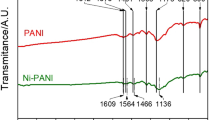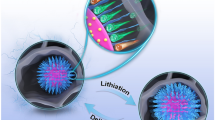Abstract
Three kinds of composites were built by nitrogen-doped graphene and phosphomolybdic acid. Based on the density functional theory (DFT), the combined energies, charge populations, orbital distributions and densities of states (DOS) were calculated. The calculated results show that the short-range interactions can be formed by oxygen atoms and nitrogen atoms, and the charge can be transferred from phosphomolybdic acid to graphene. It is found that the conductive bands (CB) of phosphomolybdic acid move to the lower-energy level. At the same time, more valence bands (VB) were found in DOS of three composites. Finally, the reason for the excellent capacitive ability of the composites is revealed. That is, nitrogen-doped graphene can improve the capacitive ability of the material by receiving the excessive electrons on surface of phosphomolybdic acid.





Similar content being viewed by others
References
S.X. Guo, Y. Zhang, X. Zhang, C.D. Easton, D.R. MacFarlane, J. Zhang, Phosphomolybdic acid-assisted growth of ultrathin bismuth nanosheets for enhanced electrocatalytic reduction of CO2 to formate. ChemSusChem 12(5), 1091–1100 (2019)
M. Hatori, S. Moriya, M. Fujimori, S. Kobayashi, H. Ikota, K. Shirabe, H. Yokoo, K. Kimura, M. Saio, Phosphomolybdic acid prevents nonspecific nuclear staining by picrosirius red but is converted to molybdenum blue by blue light. J. Histochem. Cytochem. 68(9), 621–634 (2020)
X. Jia, L. Shen, M. Yao, Y. Liu, W. Yu, W. Guo, S. Ruan, Highly efficient low-bandgap polymer solar cells with solution-processed and annealing-free phosphomolybdic acid as hole-transport layers. ACS Appl. Mater. Interfaces 7(9), 5367–5372 (2015)
M. Zhang, T. Wei, A.M. Zhang, S.-L. Li, F.-C. Shen, L.-Z. Dong, D.-S. Li, Y.-Q. Lan, Polyoxomolybdate–polypyrrole/reduced graphene oxide nanocomposite as high-capacity electrodes for lithium storage. ACS Omega 2(9), 5684–5690 (2017)
Y. Nishimoto, D. Yokogawa, H. Yoshikawa, K. Awaga, S. Irle, Super-reduced polyoxometalates: excellent molecular cluster battery components and semipermeable molecular capacitors. J. Am. Chem. Soc. 136(25), 9042–9052 (2014)
F. Joucken, Y. Tison, P. Le Fevre, A. Tejeda, A. Taleb-Ibrahimi, E. Conrad, V. Repain, C. Chacon, A. Bellec, Y. Girard, S. Rousset, J. Ghijsen, R. Sporken, H. Amara, F. Ducastelle, J. Lagoute, Charge transfer and electronic doping in nitrogen-doped graphene. Sci. Rep. 5, 14564 (2015)
A. Kumar, K. Banerjee, M. Dvorak, F. Schulz, A. Harju, P. Rinke, P. Liljeroth, Charge-transfer-driven nonplanar adsorption of F4TCNQ molecules on epitaxial graphene. ACS Nano 11(5), 4960–4968 (2017)
S.S. Kwon, J.H. Shin, J. Choi, S. Nam, W.I. Park, Defect-mediated molecular interaction and charge transfer in graphene mesh-glucose sensors. ACS Appl. Mater. Interfaces 9(16), 14216–14221 (2017)
A. Ferre-Vilaplana, E. Herrero, Charge transfer, bonding conditioning and solvation effect in the activation of the oxygen reduction reaction on unclustered graphitic-nitrogen-doped graphene. Phys. Chem. Chem. Phys. 17(25), 16238–16242 (2015)
D. Jiang, X. Du, Q. Liu, N. Hao, K. Wang, MoS2/nitrogen doped graphene hydrogels p-n heterojunction: efficient charge transfer property for highly sensitive and selective photoelectrochemical analysis of chloramphenicol. Biosens. Bioelectron. 126, 463–469 (2019)
W. Pei, T. Zhang, Y. Wang, Z. Chen, A. Umar, H. Li, W. Guo, Enhancement of charge transfer between graphene and donor-pi-acceptor molecule for ultrahigh sensing performance. Nanoscale 9(42), 16273–16280 (2017)
L. Huder, C. Rinfray, D. Rouchon, A. Benayad, M. Baraket, G. Izzet, F. Lipp-Bregolin, G. Lapertot, L. Dubois, A. Proust, L. Jansen, F. Duclairoir, Evidence for charge transfer at the interface between hybrid phosphomolybdate and epitaxial graphene. Langmuir 32(19), 4774–4783 (2016)
S. Fan, X. Tang, D. Zhang, X. Hu, J. Liu, L. Yang, J. Su, Ambipolar and n/p-type conduction enhancement of two-dimensional materials by surface charge transfer doping. Nanoscale 11(32), 15359–15366 (2019)
J. Gao, M. Tong, Z. Xing, Q. Jin, J. Zhou, L. Chen, H. Xu, G. Li, A covalently linked dual network structure achieved by rapid grafting of poly(p-phenylenediamine)-phosphomolybdic acid on reduced graphene oxide aerogel for improving the performance of supercapacitors. Chem. Commun. (Camb) 56(53), 7305–7308 (2020)
M.M. Giangregorio, W. Jiao, G.V. Bianco, P. Capezzuto, A.S. Brown, G. Bruno, M. Losurdo, Insights into the effects of metal nanostructuring and oxidation on the work function and charge transfer of metal/graphene hybrids. Nanoscale 7(30), 12868–12877 (2015)
M. Coros, C. Varodi, F. Pogacean, E. Gal, S.M. Pruneanu, Nitrogen-doped graphene: the influence of doping level on the charge-transfer resistance and apparent heterogeneous electron transfer rate. Sensors (Basel) 20(7), 1815 (2020)
G. Sarau, M. Heilmann, M. Bashouti, M. Latzel, C. Tessarek, S. Christiansen, Efficient nitrogen doping of single-layer graphene accompanied by negligible defect generation for integration into hybrid semiconductor heterostructures. ACS Appl. Mater. Interfaces 9(11), 10003–10011 (2017)
C. Bie, H. Yu, B. Cheng, W. Ho, J. Fan, J. Yu, Design, fabrication, and mechanism of nitrogen-doped graphene-based photocatalyst. Adv. Mater. 33(9), 2003521 (2021)
M.R. Karim, M.M. Rahman, A.M. Asiri, S. Hayami, Branched alkylamine-reduced graphene oxide hybrids as a dual proton-electron conductor and organic-only water-splitting photocatalyst. ACS Appl. Mater. Interfaces 12(9), 10829–10838 (2020)
C.V. Pham, S. Repp, R. Thomann, M. Krueger, S. Weber, E. Erdem, Charge transfer and surface defect healing within ZnO nanoparticle decorated graphene hybrid materials. Nanoscale 8(18), 9682–9687 (2016)
J. Xu, X. Cao, J. Xia, S. Gong, Z. Wang, L. Lu, Phosphomolybdic acid functionalized graphene loading copper nanoparticles modified electrodes for non-enzymatic electrochemical sensing of glucose. Anal. Chim. Acta 934, 44–51 (2016)
M.A. Yu, Y. Feng, L. Gao, S. Lin, Phosphomolybdic acid supported single-metal-atom catalysis in CO oxidation: first-principles calculations. Phys. Chem. Chem. Phys. 20(31), 20661–20668 (2018)
G. Qiu, Q. Xiao, Y. Hu, W. Qin, D. Wang, Theoretical study of the surface energy and electronic structure of pyrite FeS2 (100) using a total-energy pseudopotential method, CASTEP. J. Colloid Interface Sci. 270(1), 127–132 (2004)
S. Grimme, Semiempirical GGA-type density functional constructed with a long-range dispersion correction. J. Comput. Chem. 27(15), 1787–1799 (2006)
M. Korth, W. Thiel, Benchmarking semiempirical methods for thermochemistry, kinetics, and noncovalent interactions: OMx methods are almost as accurate and robust as DFT-GGA methods for organic molecules. J. Chem. Theory Comput. 7(9), 2929–2936 (2011)
Acknowledgements
This project was supported by the Science Foundation of Shaan’xi Province (No. 2021JM-516), Shaan’xi Provincial Education Department Project (No. 18JK0836), Undergraduate Training Programs for Innovation (No. 201828004) and the Teaching Reform Project (No. 2017Y007).
Author information
Authors and Affiliations
Corresponding author
Additional information
Publisher's Note
Springer Nature remains neutral with regard to jurisdictional claims in published maps and institutional affiliations.
Rights and permissions
About this article
Cite this article
Zhou, C., Wang, C., Fan, G. et al. DFT Study on Capacitive Property of Composites Built by Phosphomolybdic Acid with Nitrogen-Doped Graphene. J Inorg Organomet Polym 31, 4473–4479 (2021). https://doi.org/10.1007/s10904-021-02081-3
Received:
Accepted:
Published:
Issue Date:
DOI: https://doi.org/10.1007/s10904-021-02081-3




